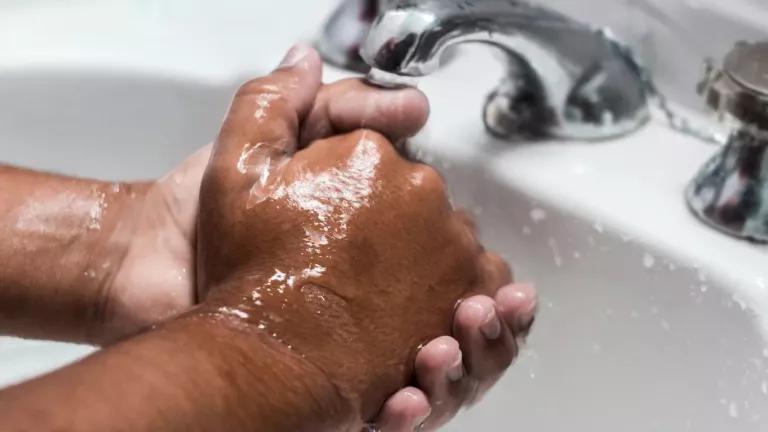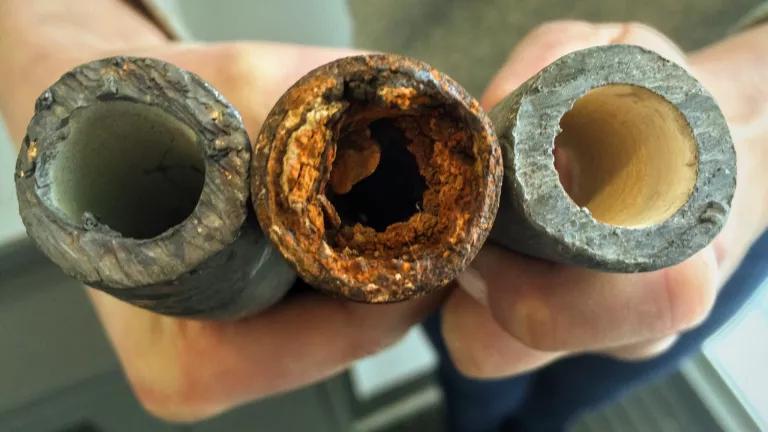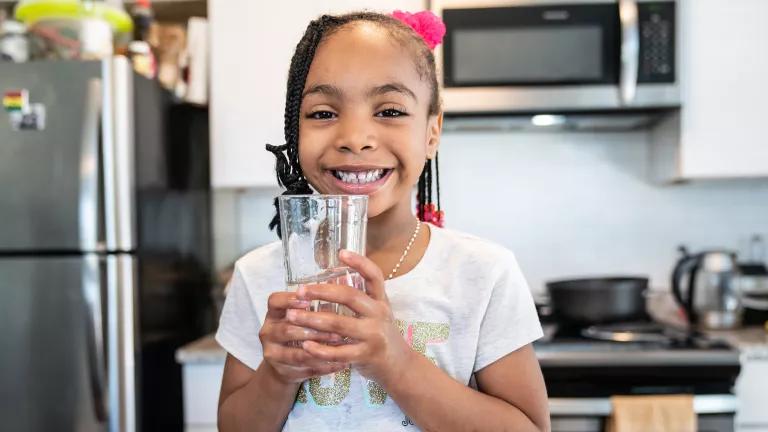A New Tool for Water Utilities: The Business Case for Affordability
Downloadable Tool Available to Support Development of Low-Income Discount Programs

Fran Jacquier
Millions of people in the United States struggle to afford their water bills and face dire consequences as a result, including loss of access to water, loss of housing, and more. It should go without saying that the most important reason to solve this problem is to protect everyone’s right—everyone’s human right—to safe water and sanitation. That’s the whole purpose of our public water and wastewater systems: to protect human health and the environment for everyone in their service areas.
Many leaders in the water utility sector see it that way too. But, whether or not utility managers define their mission as protecting the human right to water, they understand that their ability to fund operations, maintenance, and improvement of their infrastructure is threatened when people can’t afford to pay their bills.
That’s because the vast majority of funding for these systems comes from ratepayers—and it will continue to, unless and until there’s a new paradigm for funding water systems in the United States.
If you send customers water bills they can’t afford—especially low-income customers who struggle every month to make ends meet—they may not pay those bills reliably. This “often result[s] in increased costs and decreased revenues for water and wastewater utilities, impacting all customers, rich and poor alike,” as the USEPA’s Environmental Financial Advisory Board has explained.
And a high rate of customer nonpayment due to unaffordable bills can even increase the utility’s cost of borrowing, as credit rating agencies take into account a utility’s collection rates.
In short, unaffordable water bills are a money-loser for utilities, which can threaten a utility’s financial stability.
But if you send customers bills they can afford given their household income, they’re much more likely to pay those bills on time, in full, and voluntarily (i.e., without the utility expending resources to collect unpaid bills). And that’s a financial benefit to the utility and all of its customers.
So, there’s a “business case” for adopting programs that ensure bills are affordable for low-income residents. That’s true whether a utility is publicly-owned or privately-owned.
The new Water Affordability Business Case Tool can help.
The business case is widely acknowledged in both the energy and water utility sectors, as explored later in this blog. In the water sector, though, it has not been applied widely. It holds untapped potential to help water systems overcome perceived financial and legal barriers to offering low-income discounts.
Now, there's a new tool to meet that need. The “Water Affordability Business Case Tool” allows utilities to quantity the business case for water affordability, by modeling the financial impacts on the utility of offering low-income discounts.
NRDC commissioned the Tool from a technical expert in utility affordability, who has decades of experience planning, implementing, and evaluating low-income utility affordability programs for clients—including water and energy utilities, state agencies, federal agencies, and non-profit organizations.
The Tool allows users to model a range of discount program designs, including "percentage of income" affordability programs.
We beta tested the Tool in 2022 with several water and wastewater utilities, receiving positive feedback that helped improve it. The Tool is now available as a free download here.
The former deputy director of Greater Cincinnati Water Works said of their beta test experience: “GCCW was fortunate to participate as a tester of the business case tool and definitely sees the applicability to any utility wanting to build a business case for developing a customer affordability program.”
Verna Arnette
The Tool is accompanied by several supporting resources:
- A FAQ & Quick Start Guide, which explains how the Tool works, summarizes the required data inputs (from internal utility records and the U.S. Census Bureau), and describes the types of results (or outputs) the Tool provides.
- A full User Manual, which provides detailed instructions and guidelines for using the Tool, along with a thorough explanation of its methodology and underlying premises and assumptions.
- A recorded webinar, which features the technical expert who developed the Tool and a representative of a major water utility that is using it to support development of a low-income discount program. (A shorter version of the webinar can be found here.)
- A pair of case studies based on historical collections data from Pennsylvania energy utilities and Philadelphia's water utility, which illustrate the financial benefits to utilities of providing discounts to low-income utility customers.
The Tool is designed primarily for use by water, wastewater, and stormwater utilities that are considering low-income discount programs. Additionally, community-based organizations, state and federal oversight agencies, and other stakeholders may wish to encourage utilities to use the Tool. In some cases, they may be able to run the Tool independently using publicly available data.
There’s a clear need for more and better utility-level programs to address low-income affordability.
The Tool complements an extensive Water Affordability Advocacy Toolkit, which NRDC and National Consumer Law Center published in 2022. That Toolkit provides policy recommendations and best practices concerning, among other things, low-income assistance and affordability programs.
Some water and wastewater utilities currently offer some form of low-income discount. But, as explained in last year’s Toolkit, almost all of those programs are far too limited to ensure affordable bills and most utilities have no discount program at all.
The business case approach is accepted in the energy and water utility sectors.
The business case for low-income discounts is well-established in the energy utility sector. Studies have shown that affordable bill programs help energy utilities improve their bottom lines, through increased customer revenues and/or increased “net back” (i.e., customer revenue minus the costs of collecting unpaid bills).*
One of the most important insights is that discounted rates are not simply a cost to the utility, in the form of lost billing revenue and program administrative costs. Rather, the utility experiences offsetting increases in revenue and avoided costs that result from making bills more affordable to customers currently struggling to pay, which the Tool allows users to model.
For example, providing 1,000 customers with a $100 discount is not a cost of $100,000 to the utility. Low-income customers pay their non-discounted bills at a lower rate than residential customers as a whole, so the baseline revenue from non-discounted bills is less than the face value of those bills. And program participants pay their discounted bills at a higher rate than non-participating low-income customers, so utilities recover a greater percentage of amounts billed to participants than they would otherwise.
Plus, discount programs reduce the utility’s costs of collecting unpaid debts (such as disconnecting and reconnecting customers), reduce the utility’s carrying costs of customer debt, and reduce other lost utility revenues that result from accounts being disconnected.
It is not a novel idea to apply this business case to the water sector. Indeed, water utility associations’ publications expressly acknowledge the business case for low-income discounts. Here's how the American Water Works Association’s (AWWA’s) rate-setting “bible” describes the "Business Case for Creating Affordability Programs":
“When customers have trouble paying utility bills, the cost to the utility is manifested in increased arrearages, late payments, disconnection notices, and service terminations….Some of the specific advantages of adopting customer financial assistance programs include…reducing utility collection costs, arrearages, disconnects, and reconnects, which improves the utility’s bottom line….”**
Similarly, a Water Research Foundation report on low-income affordability explained that “customer assistance programs have been shown to be capable of producing more total revenue for the dollars expended.”
AWWA’s executive director for government affairs noted in the association’s journal that:
“frequent service shutoffs and resolving bad debt from customers who cannot afford their rates can be more expensive for a utility than instituting a [customer assistance program] and assisting customers in paying their bills . . . The benefit to the utility of having discounts or lower rates for low-income customers is the increased likelihood of collecting payment from these customers.”
And the Water Environment Foundations’ guide to affordability explains that:
- “A successful affordability program can enhance a customer’s ability to pay bills on time and can help utilities reduce both the number of uncollectible bills and the average time of accounts receivable. The reduction in bad debts can help offset affordability program costs”; and
- “Providing such assistance can reduce the administrative costs of dealing with uncollectible accounts (the cost of disconnecting service and reinstating service after the overdue amounts have been reconciled either through payment or some other mechanism such as a payment plan).”
This is borne out by a case study of Philadelphia's water affordability program, which found that collectability increased dramatically among low-income customers participating in the program, as compared to non-participating low-income customers. (And, as noted in the case study, participation rates are rapidly increasing.)
The Business Case Tool allows users to consider a range of discount program designs, including “percentage-of-income” affordability programs.
The Tool evaluates three types of discount program:
- “Percentage of Income Program” (PIP), in which bills for participating households are capped at a percentage of income deemed by the User to be “affordable.”
- “Percentage of Bill” (POB) program, in which bills for participating households are set equal to a percentage discount from the total bill at standard rates. A POB may be designed to achieve affordable bills, by providing a larger percentage discount for households at the lowest income levels. Alternatively, a POB may offer the same percentage discount for all participating households, without regard to whether the resulting bill is affordable.
- “Fixed Dollar Discount” (FDD) program, in which each participating household receives a set dollar-amount discount on its bill.
Within each program type, the User can select from various program design options. The User can also assess results using a range of participation rates by eligible customers, program administrative costs, and other factors.
The business case can help address legal concerns with low-income discounts.
Utilities are often concerned that state law limits their ability to offer low-income discounts. Sometimes this is based on a misimpression that discounts are prohibited when, in fact, a state’s laws are simply ambiguous. In those cases, the Business Case Tool may help utilities provide a legal rationale for funding low-income discount programs with rate revenues, based on financial benefits that accrue to ratepayers as a whole.
As explained in a Water Research Foundation report on low-income affordability:
“If a special rate has a purpose broader than simply to improve the affordability of bills to low-income customers, it is more likely that the rate will be [considered permissible under state law]. State regulatory commissions have approved low-income discount rates not solely as social policy, but rather as sound business alternatives to a cycle involving the billing of unaffordable rates, followed by entering into unaffordable payment plans, followed by payment plan breaches, followed by yet additional unaffordable payment plans.”
Similarly, in a report funded by the major national water and wastewater utility associations, the University of North Carolina’s Environmental Finance Center explained that the business case argument can provide legal support for ratepayer-funded programs: “Rather than framing [an assistance program] as a subsidized rate class, present it as an essential cost of running a utility that provides financial benefits to all customers.”
The Tool doesn’t recommend how to fund discount programs, but it can help utilities figure out funding needs and funding options.
The Business Case Tool allows users to model the net financial impacts of low-income discount programs on a particular utility. It does not recommend how to pay for a low-income discount program. But, by quantifying financial impacts, the Tool can help a utility evaluate options for funding a program—whether from ratepayer revenue or from other sources.
The Tool can evaluate utility revenue impacts in a scenario in which costs are recovered from (i.e., paid for by) nonparticipating ratepayers. Alternatively, a user can run a scenario in which those costs are not recovered from nonparticipating ratepayers. That option allows the Tool to determine whether the discount “pays for itself” and, if it does not, to quantify any net costs of a program that the utility needs to recover from somewhere. Quantifying these costs can help the utility separately evaluate potential funding options.
For example, the state Michigan recently appropriated $25 million to help utilities offset the costs of providing percentage-of-income programs. Building on that initial down-payment, utilities and water affordability advocates are now working to secure additional state funds.
For more information….
Please reach out to us at WaterTool@nrdc.org with any questions or feedback!
NOTES:
*A case study of several Pennsylvania energy utilities can be found here. Findings from energy utility programs in Indiana and Colorado are summarized on pages 4-6 here.
**American Water Works Association (AWWA), M1 Principles of Water Rates, Fees and Charges, Seventh Edition, 2017, pp. 217-18.

Excerpt from: American Water Works Association (AWWA), M1 Principles of Water Rates, Fees and Charges, Seventh Edition, 2017, pp. 217-18.




